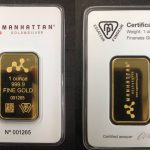Silver and gold are perhaps the most iconic pairing of precious metals. The two seem to always be together. Silver and gold always compliment each other in jewelry designs. There are tons of songs titled “Silver and Gold.” This blog is written by Manhattan Gold & Silver. But, when you need to separate this duo, an age old refining trick called “gold parting” comes in handy.
Despite having different colors and or physical properties, gold and silver are quite similar on a chemical level. During excavation, the two are often found together forming an alloy known as electrum. However, electrum isn’t always desirable. When coinage started gaining popularity thousands of years ago, people needed a way to standardize the purity of the gold and silver they were using. As a result, the first technique of gold parting was invented: salt cementation.
If you visit our Youtube channel, you can see that smelting metal is not a simple task. It takes care, skill, and incredible amounts of heat. But relatively speaking, salt cementation is pretty easy. In a jar, add gold/silver alloy, some burnt clay or old brick dust, salt, and just enough urine to moisten it all (trust us). Seal the jar and keep it heated, but not hot enough to melt the gold – less than 1000°C. In about 24 hours, the gold should be nearly silver-free at around 90% purity or greater.
Salt cementation sounds like a really oddball stew, but there is complex chemistry at work! When heated in the presence of silica and alumina (found in the clay/brick dust), salt breaks down to form hydrochloric acid and chlorine. The acidity in urine helps this decomposition along. The hydrochloric acid from this reaction interacts with the silver to create silver chloride, which separates from the gold. When that occurs, the reaction is volatile – which is why it’s important to keep the jar sealed. After removing the gold, you can convert the silver chloride back into silver, giving you two separate, purified samples of precious metals.
Of course, modern metal refining has come up with more effective and efficient methods of gold parting, such as the Miller Process and the Wohlwill Process. Thankfully, neither process requires urine.










